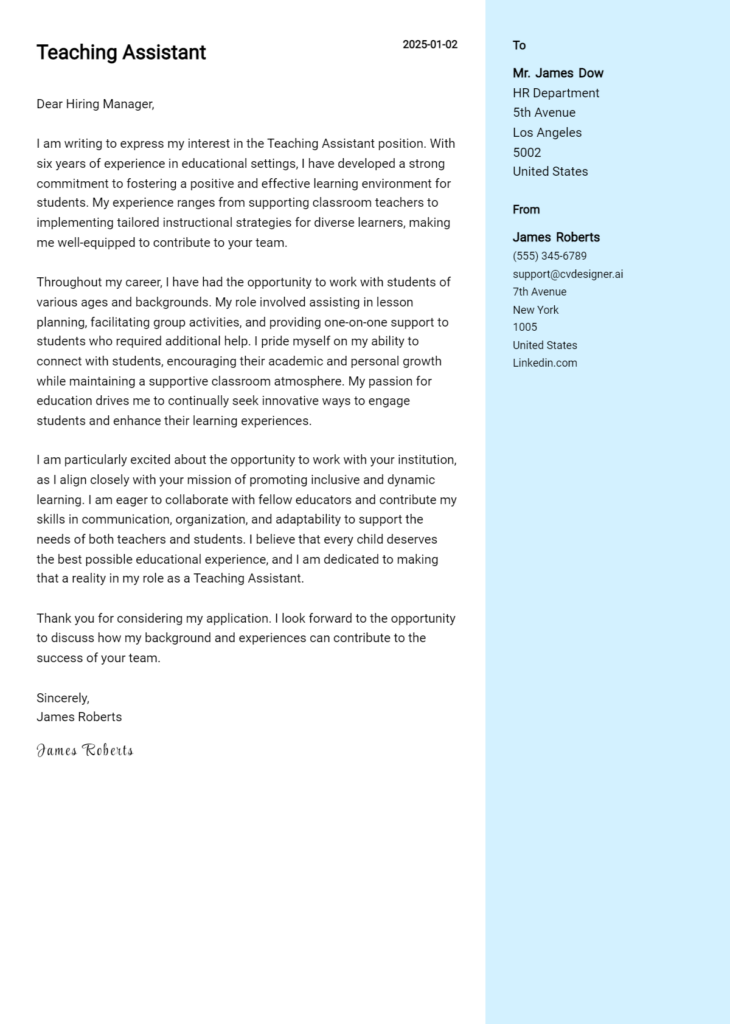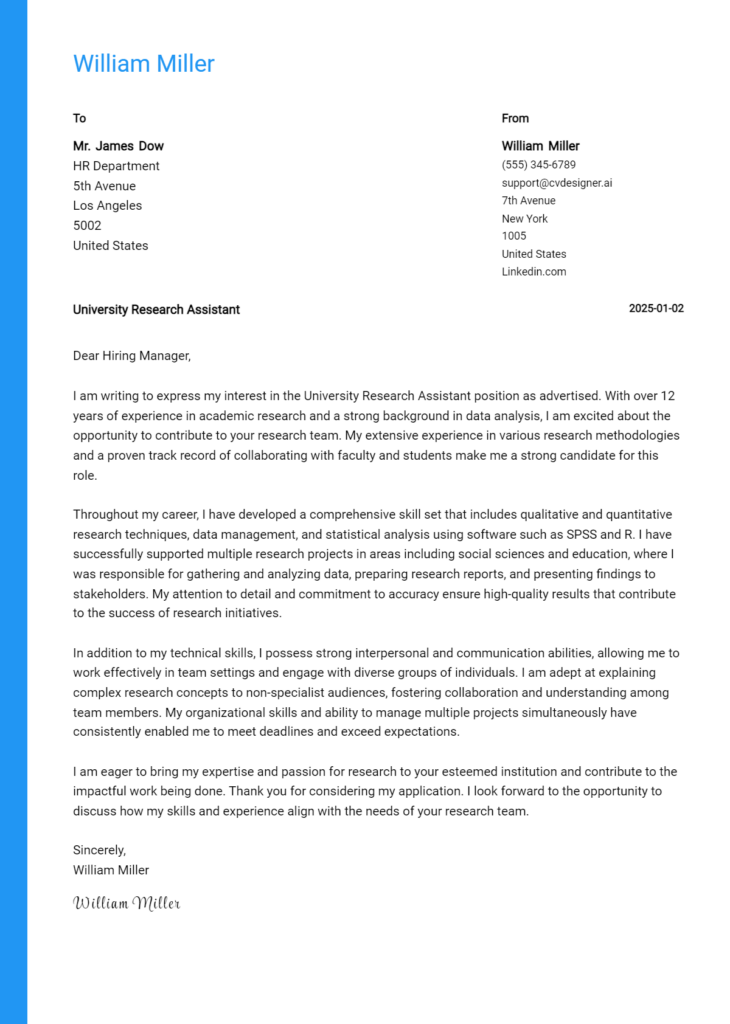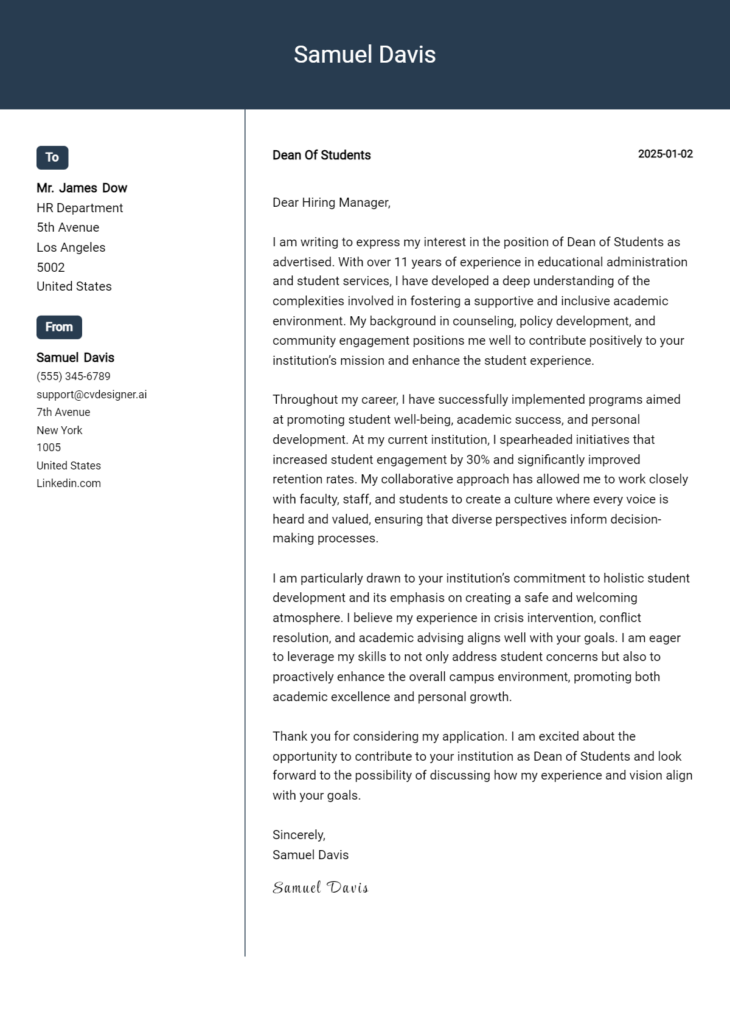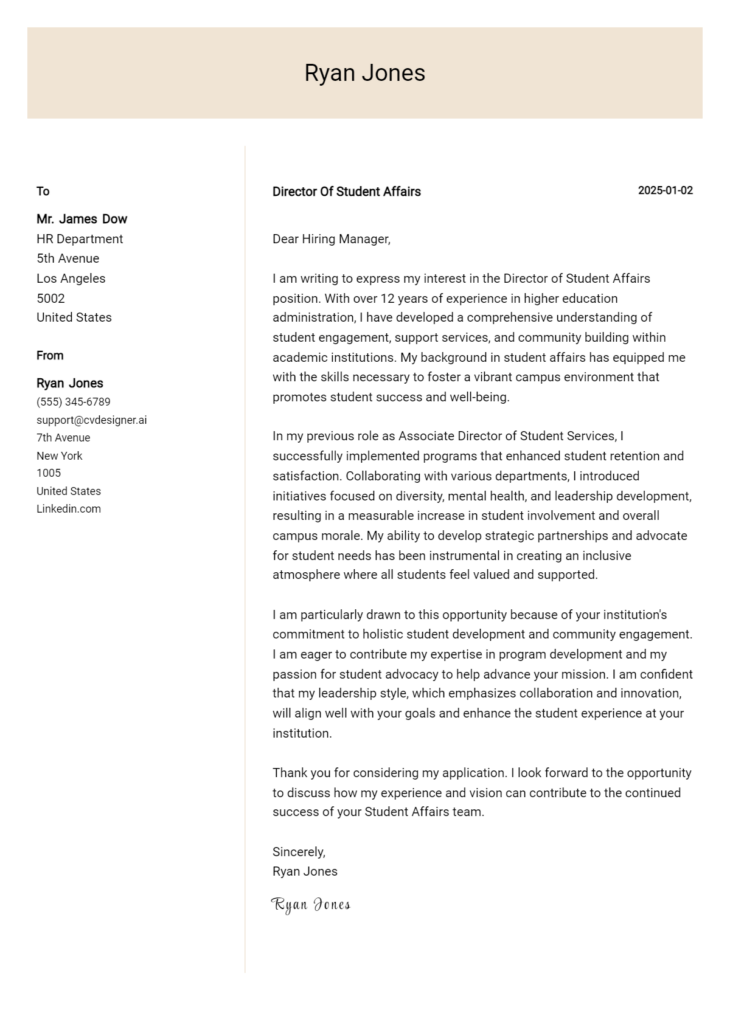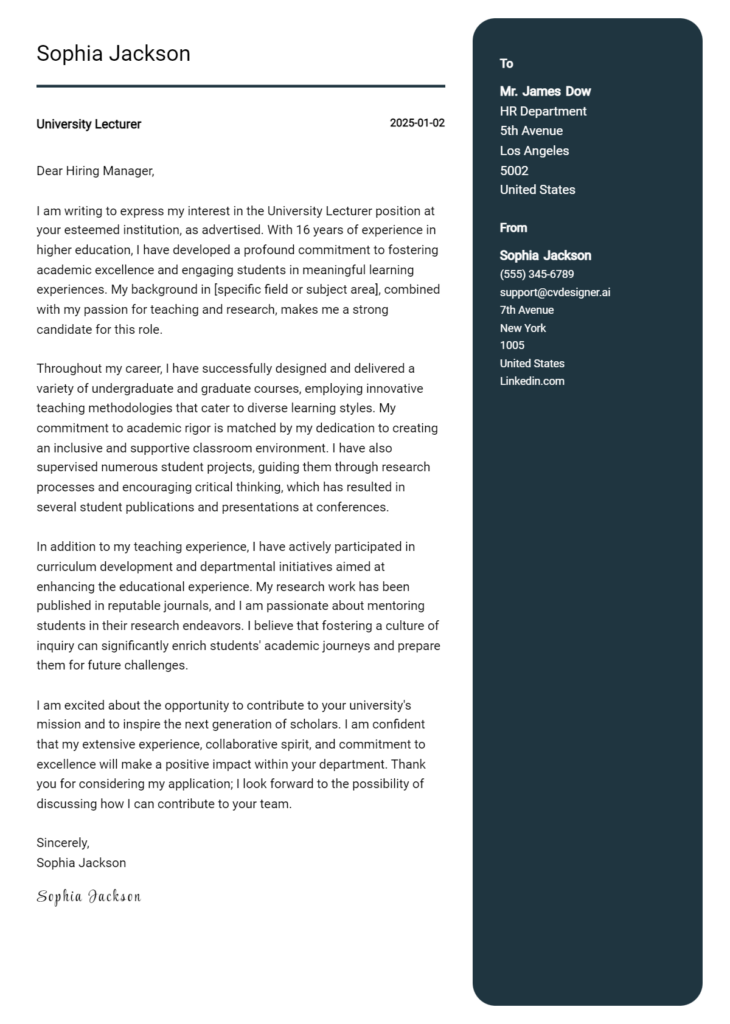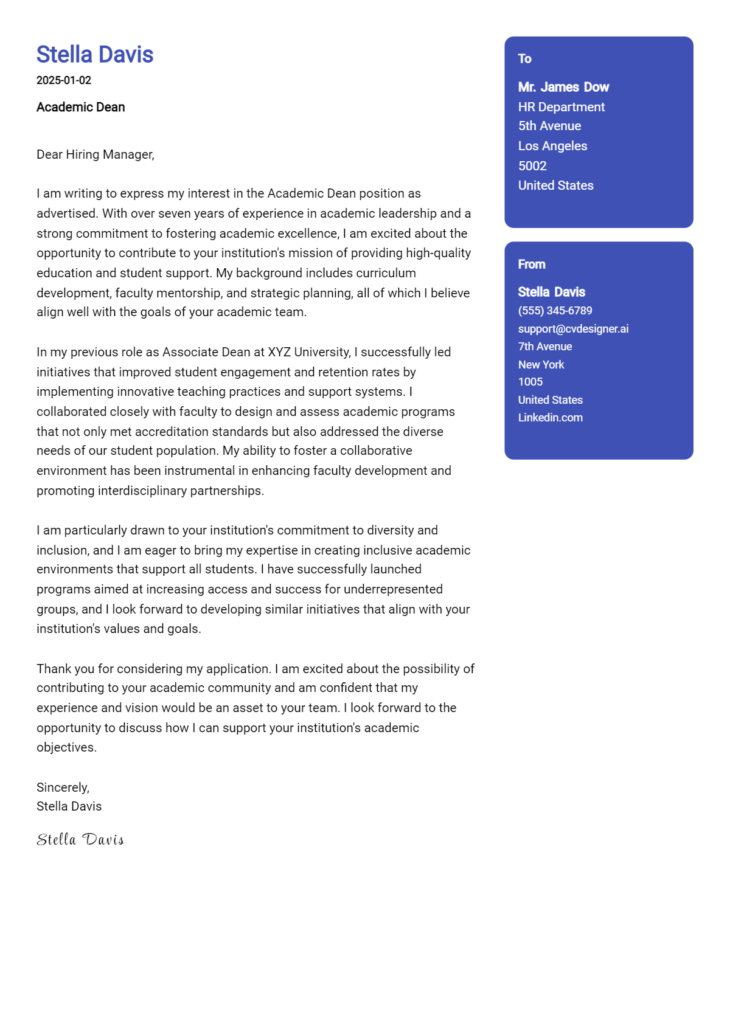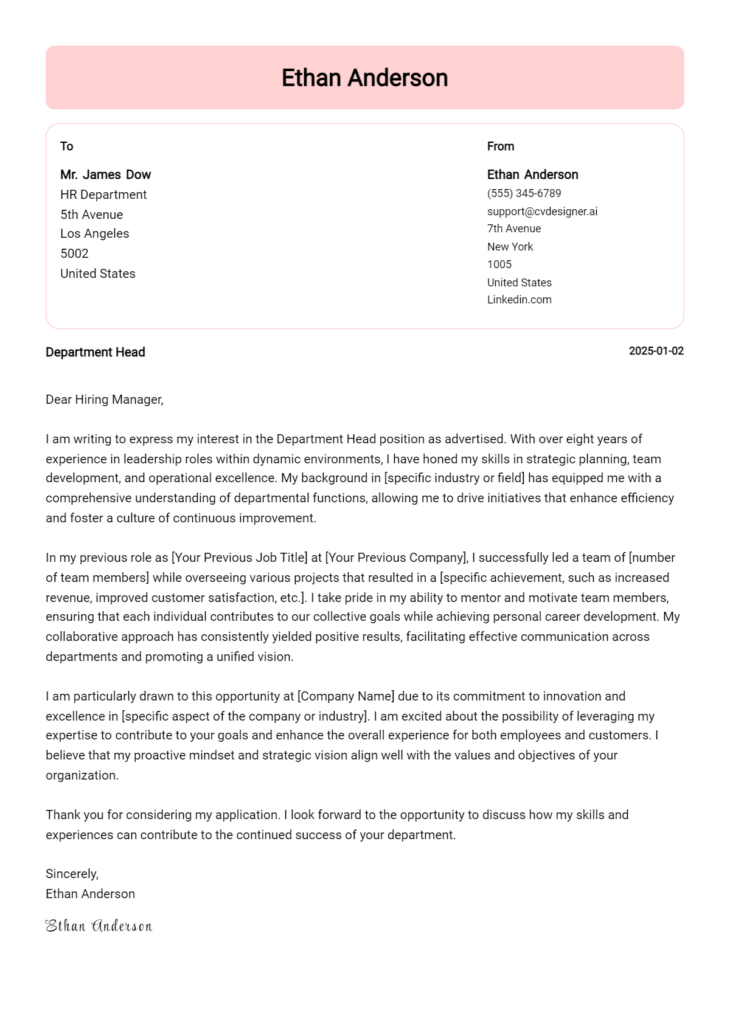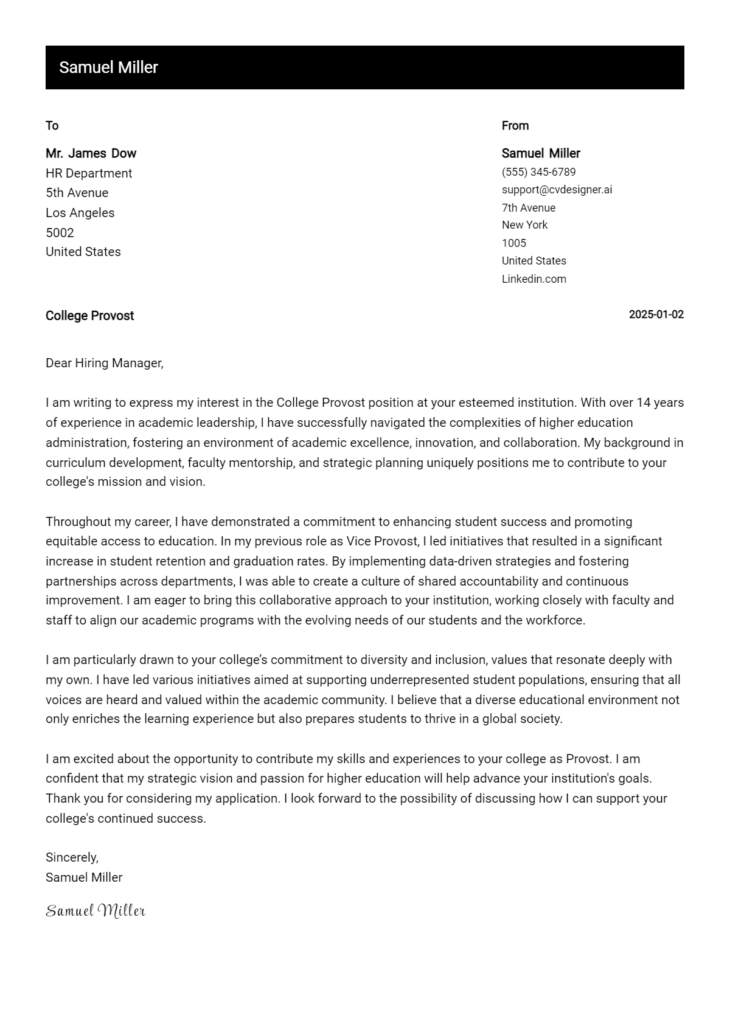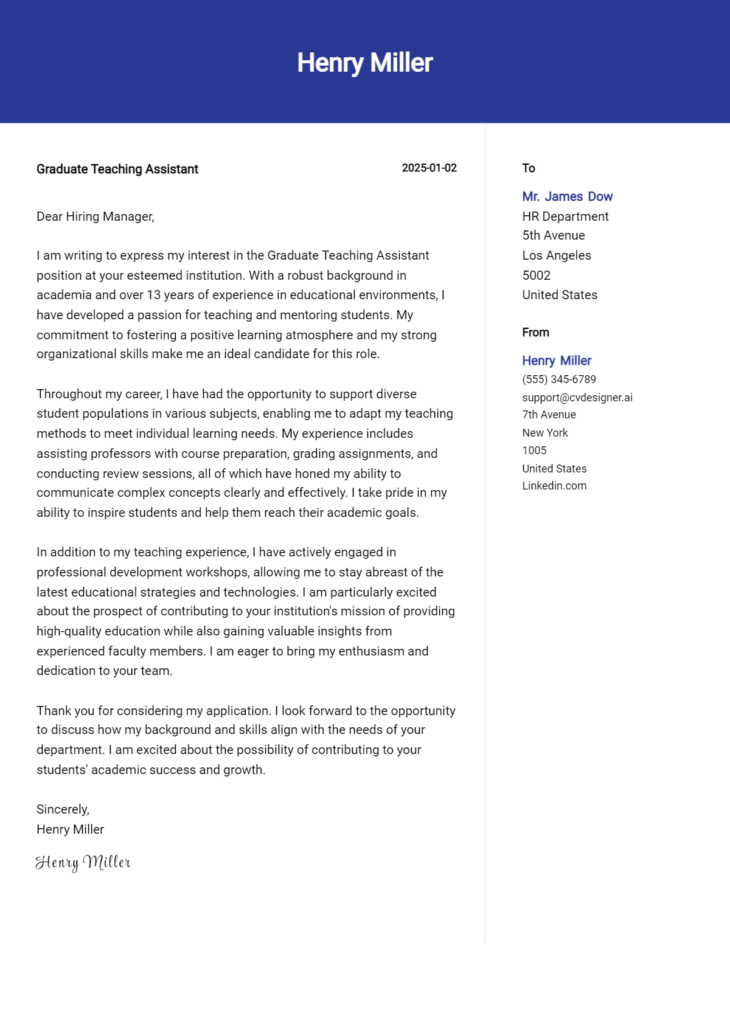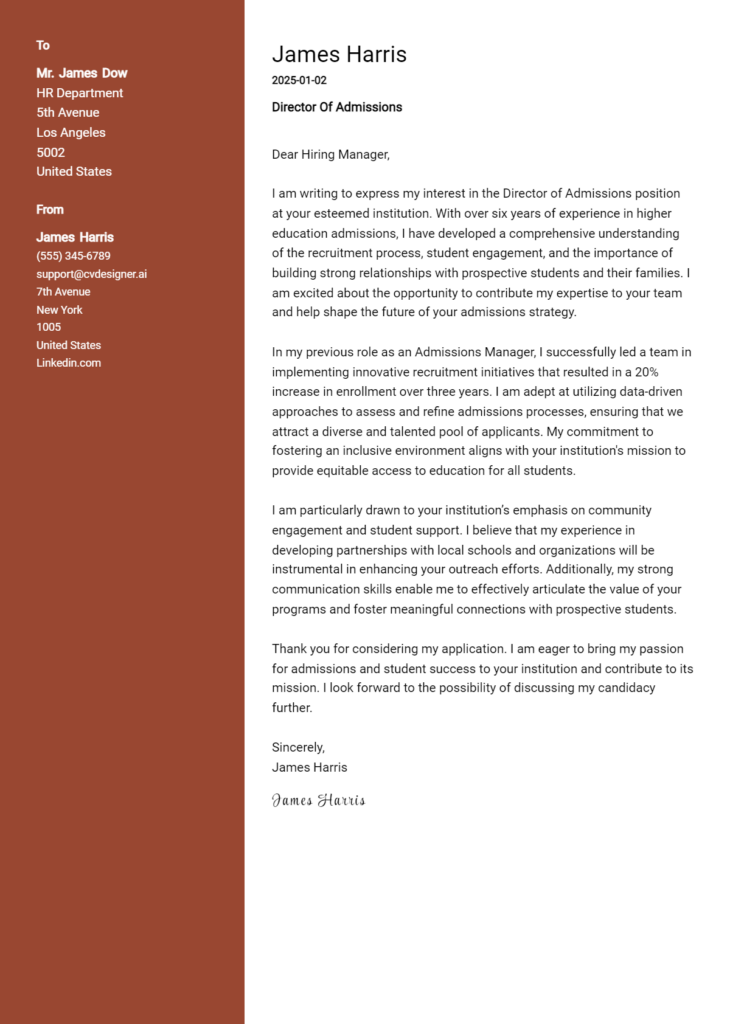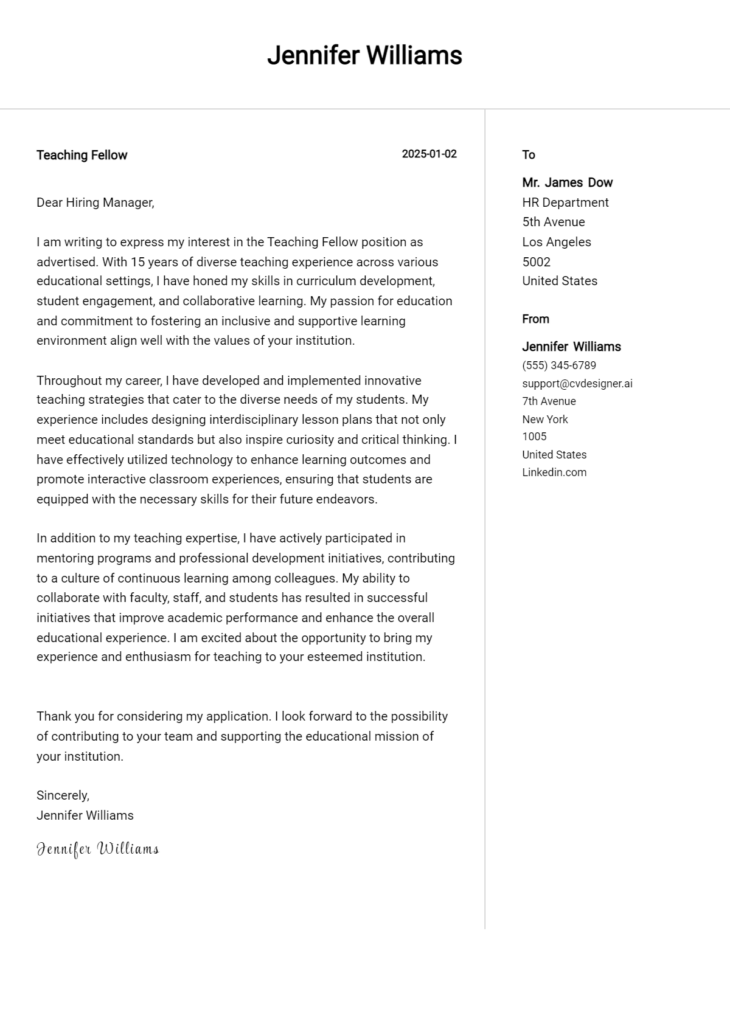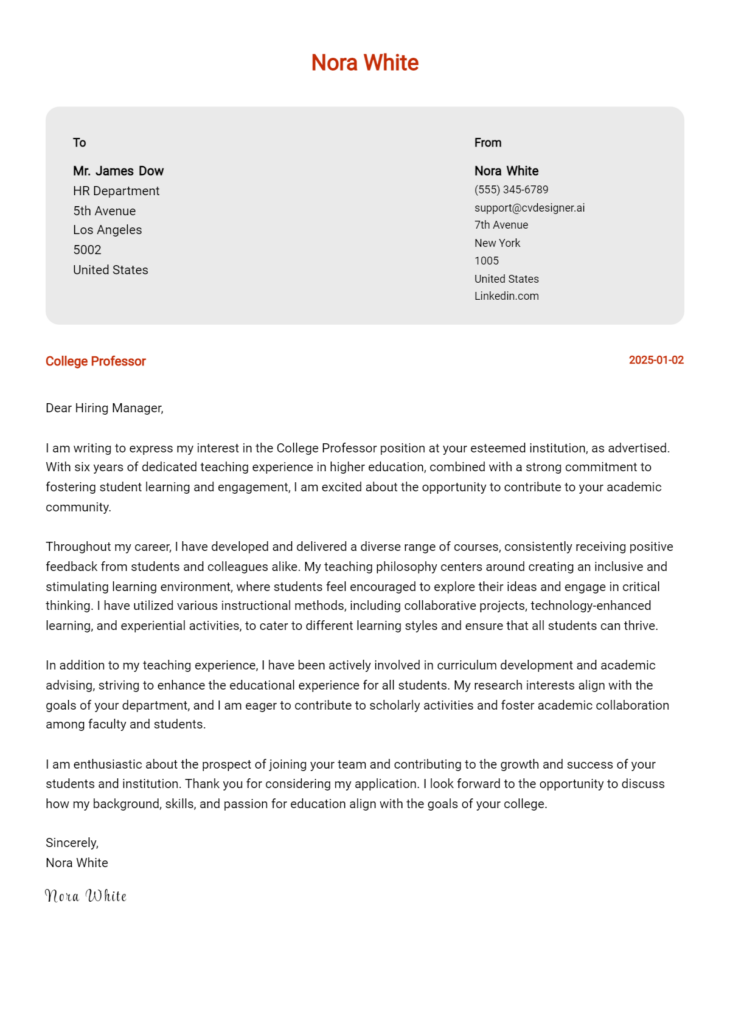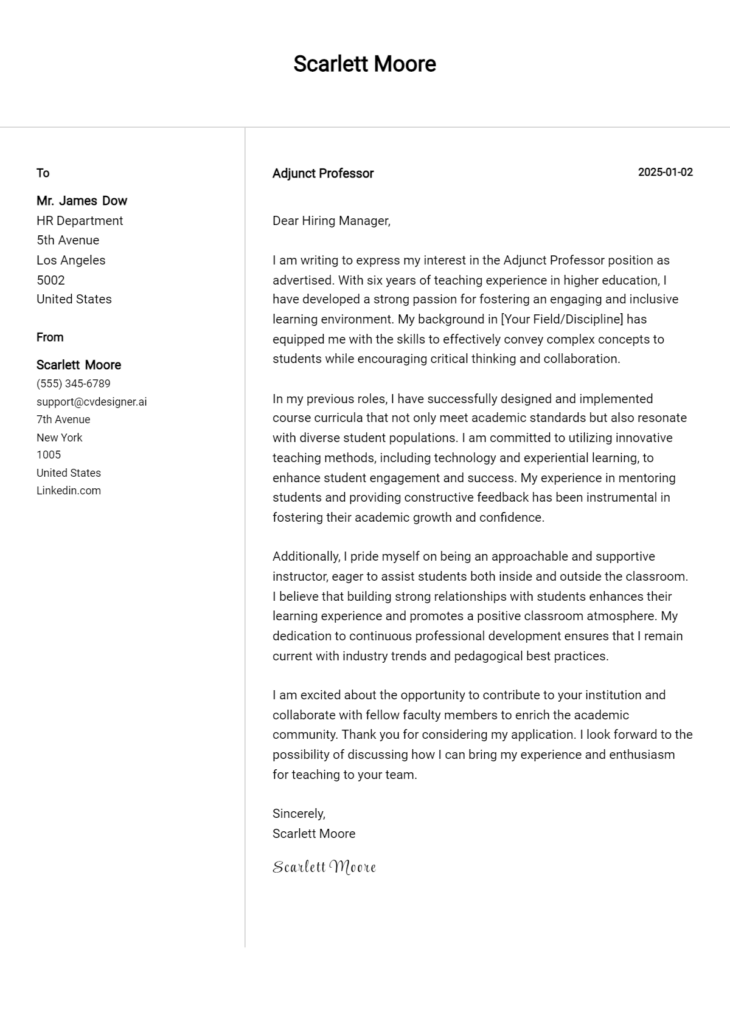Registrar Cover Letter Examples
Explore additional Registrar cover letter samples and guides and see what works for your level of experience or role.
How to Format a Registrar Cover Letter?
Crafting a well-structured cover letter is essential for a Registrar as it not only outlines your qualifications but also demonstrates your organizational skills and attention to detail—qualities that are paramount in this role. A professionally formatted cover letter can set you apart from other candidates by conveying your ability to manage sensitive information, maintain accurate records, and support academic operations effectively.
In this guide, we will delve into the key components of an effective Registrar cover letter, providing insights and tailored examples to help you create a standout application.
We will focus on the essential sections of a professional cover letter, including:
- Cover Letter Header
- Cover Letter Greeting
- Cover Letter Introduction
- Cover Letter Body
- Cover Letter Closing
Each section is crucial for presenting your qualifications and professionalism. Let’s break down each part and explore how to make your Registrar cover letter shine.
Importance of the Cover Letter Header for a Registrar
The cover letter header is a crucial component of any job application, particularly for a Registrar, as it sets the tone for professionalism and clarity. A well-structured header includes essential information such as your contact details, the date, and the recipient’s information. This not only provides a clear point of reference for the reader but also reflects your attention to detail and organizational skills—key attributes for a Registrar role. A strong header leaves a positive first impression, whereas a weak header can detract from the overall effectiveness of your application.
Strong Example
John Smith 123 Main Street Anytown, ST 12345 john.smith@email.com (555) 123-4567 October 1, 2023 Jane Doe Hiring Manager XYZ University 456 College Ave Anytown, ST 12345
Weak Example
Hi there, I’m applying for the Registrar position. Thanks, John
The Importance of the Cover Letter Greeting
The greeting of a cover letter plays a crucial role in establishing the tone for the entire document. A well-crafted greeting demonstrates professionalism and shows that the applicant values the opportunity to connect with the hiring manager personally. By addressing the recipient directly, candidates create a sense of engagement and respect, which can set them apart from others. To enhance personalization, it is essential to avoid generic greetings like "To Whom It May Concern." Instead, take the time to research and find out the hiring manager's name, as this small effort can make a significant impact. If you're unable to find a specific name, consider using a department title as an alternative.
Strong Greeting Example
Dear Ms. Johnson,
Weak Greeting Example
To Whom It May Concern,
Importance of a Well-Crafted Cover Letter Introduction for a Registrar
A well-crafted cover letter introduction is crucial for a Registrar position as it serves as the first impression to the hiring manager. This introductory paragraph should not only capture attention but also express genuine interest in the role while succinctly highlighting key skills or achievements relevant to the position. A strong introduction sets the tone for the rest of the letter and can significantly influence the hiring manager’s perception of the candidate.
Strong Example
Dear [Hiring Manager's Name], I am excited to apply for the Registrar position at [Institution Name], where I can leverage my extensive experience in academic administration and my passion for student success. With over five years of experience in managing admissions processes and maintaining student records at [Previous Institution], I have developed a keen eye for detail and a commitment to efficiency that I believe will benefit your team immensely. I am particularly drawn to [Institution Name]'s dedication to fostering an inclusive learning environment, and I am eager to contribute my skills in data management and student engagement to support this mission.
Weak Example
Hello, I would like to apply for the Registrar job you have posted. I have worked in schools before, and I think I could do a good job. I am organized and can handle paperwork. I hope to hear from you soon.
Purpose of the Cover Letter Body for a Registrar
The cover letter body for a Registrar serves as a critical platform for candidates to articulate their qualifications and demonstrate their fit for the role. This section allows applicants to highlight their relevant skills, experiences, and the unique value they bring to the organization. It should detail specific projects or accomplishments that showcase their ability to manage records, streamline administrative processes, and ensure compliance with institutional policies. A well-crafted cover letter body not only presents the candidate's professional background but also conveys enthusiasm for the position and the institution.
Strong Example
Dear Hiring Committee, I am excited to apply for the Registrar position at XYZ University, where I have successfully managed the registration process for over 5,000 students during my previous role at ABC College. One of my key accomplishments was leading a project to digitize student records, which reduced retrieval time by 50% and improved accuracy. Additionally, I developed a new online registration system that increased student satisfaction scores by 30%. My strong organizational skills, combined with my commitment to fostering a supportive academic environment, make me an ideal candidate for this role.
Weak Example
To Whom It May Concern, I am applying for the Registrar position. I have worked in administrative roles before and have some experience with student records. I think I would be a good fit for the job because I am organized. I have done some things at my last job, but I can’t remember all the details right now. I really want to work at your institution because it seems like a nice place.
The Importance of a Cover Letter Closing for a Registrar
The closing paragraph of a cover letter is crucial for a Registrar position as it serves to summarize your qualifications, reiterate your enthusiasm for the role, and encourage the hiring manager to take the next steps in the hiring process. A strong closing can leave a lasting impression, highlighting your readiness to contribute to the institution while prompting the reader to review your resume and consider scheduling an interview. Conversely, a weak closing may fail to convey your interest and enthusiasm, leaving the reader with a lack of motivation to follow up.
Strong Example
Thank you for considering my application for the Registrar position at your esteemed institution. I am excited about the opportunity to bring my extensive experience in academic administration and my passion for student success to your team. I am confident that my skills in data management and policy development will significantly contribute to your institution’s goals. I look forward to the possibility of discussing my application further and am eager to provide any additional information you may need. Please feel free to contact me to schedule an interview at your earliest convenience.
Weak Example
Thanks for reading my cover letter. I think I would be okay at the Registrar job. If you want to talk more, you can look at my resume. Let me know if you need anything else.
When applying for a Registrar position, a well-crafted cover letter can set you apart from other candidates. This document serves as your opportunity to showcase your technical skills, problem-solving abilities, understanding of the Software Development Life Cycle (SDLC), teamwork experience, and a commitment to continuous learning. The following tips will guide you in creating an effective cover letter that highlights your qualifications and passion for the role.
Tips for Writing an Effective Registrar Cover Letter
Highlight Your Technical Skills
Clearly outline your technical competencies relevant to the Registrar role. This could include proficiency in database management, data analysis software, or specific programming languages. Use concrete examples to illustrate how you've applied these skills in previous positions. For additional formatting ideas, consider exploring cover letter templates.Demonstrate Problem-Solving Abilities
Provide specific instances where your problem-solving skills made a significant impact. Whether you resolved a data integrity issue or streamlined a registration process, detail the challenge, your approach, and the successful outcome. This will show prospective employers that you can navigate complex situations effectively.Showcase Your Understanding of SDLC
Discuss your familiarity with the Software Development Life Cycle and how it relates to the Registrar role. Mention any experience you have with project management tools or methodologies that demonstrate your ability to contribute to software development projects, ensuring that they align with institutional requirements and user needs.Emphasize Teamwork Experience
Collaboration is key in any Registrar position. Share examples of how you've worked effectively in teams, whether in academic settings or professional environments. Highlight your role in achieving team objectives, demonstrating your ability to communicate and cooperate with others to drive success.Express Your Passion for Continuous Learning
In a rapidly changing field, showcasing a commitment to continuous improvement and professional development is vital. Mention any relevant certifications, courses, or workshops you've completed that keep you updated with industry trends. This not only reflects your dedication but also your readiness to adapt and grow within the role.
By incorporating these tips into your cover letter, you'll be well on your way to impressing hiring managers. If you need help formatting your letter or finding the right words, consider using a cover letter builder to streamline the process.
Common Mistakes to Avoid in a Registrar Cover Letter
Crafting a compelling cover letter is essential for a successful application as a Registrar. Avoiding common mistakes can significantly enhance your chances of standing out to potential employers. Here are some pitfalls to steer clear of:
- Generic Greetings: Using "To Whom It May Concern" can make your letter feel impersonal. Instead, find the hiring manager's name to personalize your greeting.
- Lack of Specificity: Failing to mention specific skills or experiences related to the Registrar role may leave your application feeling vague. Tailor your letter to highlight relevant qualifications.
- Neglecting Formatting: Poor formatting can distract from your content. Follow a professional cover letter format to ensure readability.
- Overly Lengthy Letters: A cover letter should be concise. Aim for one page and focus on your most relevant experiences and achievements.
- Ignoring Job Description: Not addressing the key responsibilities mentioned in the job description can be detrimental. Use keywords from the listing to align your skills with what the employer seeks.
- Typos and Grammatical Errors: Mistakes in your writing can create a negative impression. Always proofread your letter and consider using tools or a second pair of eyes for review.
- No Call to Action: Failing to indicate your desire for an interview can leave your letter feeling incomplete. End with a strong closing that expresses your enthusiasm for the role.
For inspiration, you might want to check out some cover letter examples that can guide you in crafting a strong application.
Cover Letter FAQs for Registrar
What should I include in my cover letter for a Registrar position?
In your cover letter, highlight relevant experience in academic administration, student services, or records management. Start by introducing yourself and expressing your interest in the Registrar position. Mention specific skills that align with the job description, such as proficiency in student information systems, data management, and compliance with educational regulations. Include examples of your achievements, like improving registration processes or enhancing data accuracy. Finally, express enthusiasm for the institution’s mission and how you can contribute to achieving it, ending with a strong closing statement that invites further discussion.
How do I tailor my cover letter for a specific Registrar job?
To tailor your cover letter, begin by thoroughly reviewing the job description. Identify key responsibilities and qualifications, and then align your experience with these points. Use specific language from the job posting, reflecting the institution’s values and culture. For instance, if the role emphasizes student engagement, discuss your past initiatives that fostered student satisfaction. Additionally, research the institution’s goals and mention how your vision aligns with them. Personalizing your cover letter not only demonstrates your genuine interest but also shows that you have taken the time to understand the role and the organization.
How long should my cover letter be for a Registrar role?
Your cover letter should ideally be one page long, typically consisting of three to four paragraphs. Aim for a concise yet comprehensive approach to highlight your qualifications and experiences. Begin with an engaging introduction, followed by a paragraph detailing your relevant experience and skills. Use the third paragraph to connect your background to the institution’s needs, and conclude with a strong closing statement that expresses your eagerness for an interview. Keeping your cover letter succinct will ensure that hiring managers can quickly grasp your qualifications without feeling overwhelmed by excessive details.
Should I include specific achievements in my cover letter?
Yes, including specific achievements is crucial in your cover letter for a Registrar position. Quantifiable results help demonstrate your capabilities and the impact you’ve made in previous roles. For example, mention a project where you improved data accuracy by a certain percentage or a process you streamlined that reduced registration time. These concrete examples provide evidence of your skills and show potential employers how you can add value to their institution. Ensure that your achievements are relevant to the responsibilities of the Registrar role, thereby reinforcing your suitability for the position.
Build your Cover Letter in minutes
Use an AI-powered cover letter builder and have your letter done in 5 minutes. Just select your template and our software will guide you through the process.


